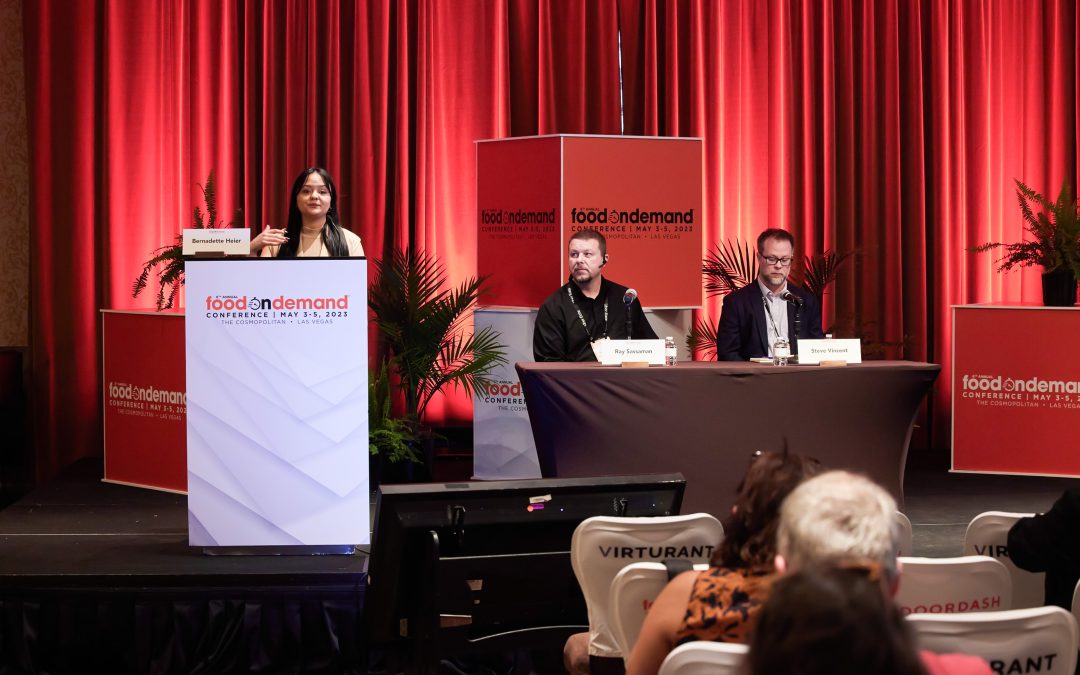Two very different virtual operators shared the keys to success they’ve discovered by bringing several virtual, delivery-only brands into their existing restaurant kitchens. As each explained, they are still learning lessons and making adjustments.
This session was moderated by Food On Demand Associate Editor Bernadette Heier, who began by asking each operator what got them to sign on the dotted line for their first virtual brands.
Steve Vincent is director, business transformation at Red Robin, the franchised burger brand that brought Donatos Pizza into several of its kitchens starting in 2021. Vincent said he and his team are still trying to learn how to maximize revenue coming out of their kitchens, but said his team picked specific virtual brands to solve both short-term and long-term challenges that arose in the beginning of the pandemic. Those were built upon a foundation first laid with that landmark Donatos partnership.
Vincent and company launched three of their own, in-house virtual brands in late 2020, but also worked with both Virtual Dining Concepts and Nextbite to bring outside brands into their Red Robin kitchens.
Based in Corvallis, Oregon, Ray Sassaman is the regional manager of Benchwarmers Bar & Grill, with nearly 20 years of restaurant experience that culminated in doing business with Nextbite once the pandemic shut down their in-store sales.
He said their first virtual brands happened out of necessity when their restaurant was shut down for in-store dining. In Sassaman’s words, “we were not only able to get our sales back through to-go, but went on to become Nextbite’s number one partner.”
Pushing for (at least) four stars

Ray Sassaman (left) of Benchwarmers Bar & Grill and Steve Vincent of Red Robin
“The idea was not that all of them were going to be successful and take off,” Vincent said of the in-house delivery-only brands. Hoping for at least one of them to stick, Chicken Sammy’s The Wing Dept. and Fresh Set were paired with outside brands, teaching the team about the big difference in managing self-made brands with those plucked off the shelf.
“Building a brand is hard … in every market and every community,” Vincent added. “And you need to take that same approach with your in-house brands,” noting that it’s much harder in the virtual space when your only touchpoint is the third-party delivery providers.
In addition, communicating to franchisees about the dollars and time invested into the virtual brands as opposed to the Red Robin core was a “constant battle” that inherently requires dividing a back-of-the-house team’s time and attention between the portfolio of brands.
Two years later, Chicken Sammy’s and Fresh set remain, of the in-house concepts, while Wing Dept. was put out to pasture, with Vincent saying that the wing category was “oversaturated” and not worth it for the handful of orders it was adding per day once the pandemic-driven wing enthusiasm cooled.
Viewing Red Robin’s kitchens as an assembly line designed to execute the core menu, keeping virtual concepts in the mix has gone as far as impacting Red Robin’s menu innovation to ensure that no brands are disrupting the flow and function on a hectic Friday night shift.
Looking deeper for opportunities with some experience under its belt, Red Robin realized its sauteed stations had excess capacity, so the company partnered to develop a product that would specifically operate in that space.
In addition, piloting with MrBeast Burger was a natural extension for its cooks given Red Robin’s expertise at making its own burgers.
“We’re experts at making burgers, so injecting something new like that into the process was really seamless because we’re already doing that,” he said.
Vincent also stressed the importance of positive reviews for brands that solely live on third-party delivery apps, which includes caring about other operators of the same brands in a given market.
“If we do a great job and are always at four or five stars, and then you have other partners in the community that aren’t doing well, what does that do to the brand reputation and does that limit the sales potential we will see?”
Keeping the cooks happy
Out in Oregon, Benchwarmers Sassaman struck similar notes, saying that his team was especially focused on keeping its Nextbite brands above four stars, which includes taking care of drivers so they enjoy coming to their locations, resulting in at-home customers receiving food that’s faster and hotter.
Because his location is in a college town with a lot of events, his crew has focused on “hitting them fast and hard” in terms of marketing that reaches out-of-town visitors. “Nextbite takes a lot of that off our plate,” he said.
Saying that Nextbite didn’t want him to launch too many virtual brands at once, he began with two different burger concepts, which wasn’t overwhelming, so he also added three different wing concepts that were also attainable, stressing that “it was really just nine different sauces.”
Not all back-of-the-house employees enjoyed the added complexity, so Sassaman found ways to create synergy between the core Benchwarmers menu and the incoming virtual brands, which ended up being a “huge success.”
He also prioritized drivers, creating dedicated parking for delivery drivers, and setting up a drive-thru window on the other side of the building, which was a tip he learned from delivery drivers.
As virtual brands have begun to saturate the U.S. restaurant scene, Sassaman said he was in favor of delivery brands like Uber Eats creating standards to ensure the “survival of the fittest” that he said will ultimately result in “better brands, better food and better operators” of virtual concepts.
Sassaman’s Benchwarmers also made what he called imperceptible changes to virtual menu items, including swapping out bulk cheese for mac-and-cheese bites in virtual brand, which he said took “zero time to prep” that reduced some concerns from his cooks.


